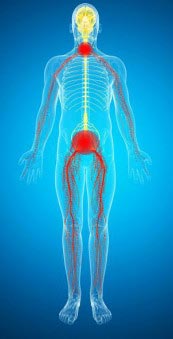Radiculopathy
 Radiculopathy refers to radiating pain, tingling, numbness and sometimes weakness that can occur with nerve irritation commonly resulting in radiating neck and arm pain or back, buttocks, and leg pain. The nerve roots are nerve fibers that form from the spinal cord and travel to different regions of the body. The cervical nerves in the neck go to the upper chest and arms. The thoracic nerves travel to the chest, and the lumbar nerves travel to the hips, buttocks, and legs. Common causes of radiculopathy are from mechanical nerve compression secondary to spinal stenosis, a condition where the spinal canal is narrowed or may also result from a herniated disk where disk material compresses the nerve roots.
Radiculopathy refers to radiating pain, tingling, numbness and sometimes weakness that can occur with nerve irritation commonly resulting in radiating neck and arm pain or back, buttocks, and leg pain. The nerve roots are nerve fibers that form from the spinal cord and travel to different regions of the body. The cervical nerves in the neck go to the upper chest and arms. The thoracic nerves travel to the chest, and the lumbar nerves travel to the hips, buttocks, and legs. Common causes of radiculopathy are from mechanical nerve compression secondary to spinal stenosis, a condition where the spinal canal is narrowed or may also result from a herniated disk where disk material compresses the nerve roots.
RADICULOPATHY SYMPTOMS
The most common symptoms of cervical radiculopathy include pain, numbness, and sometimes weakness that radiates down the shoulder and arm. Depending upon which nerves are involved, different parts of the shoulder and arm or hand can be affected. People can be hypersensitive to touch or may develop decreased sensation or may develop neurologic weakness in the muscles that are supplied by these nerves. Lumbar radiculopathy causes pain radiating into the buttocks and legs and may also cause numbness, tingling, and weakness.
DIAGNOSIS OF RADICULOPATHY
A history and physical is often very useful when determining if a patient has radiculopathy. Mechanical causes of radiculopathy are best seen on advanced imaging with a CT scan or an MRI. An MRI is especially good at looking at the spinal nerves and looking at the soft tissues of the disk, and a CT scan is often used for bony anatomy.
TREATMENT OF RADICULOPATHY
Most patients with radiculopathy will have transient symptoms that will improve with conservative treatment such as anti-inflammatory medications, rest, physical therapy and/or chiropractic care and occasionally epidural steroid injections. Patients with significant neurologic weakness or with prolonged symptoms resistant to nonoperative measures commonly benefit from surgery. The goal of surgery is to decompress the neural elements that are mechanically compressed and this relieves the pinching of the nerve, improves the circulation of the nerve and results in improvement in the clinical symptoms.
